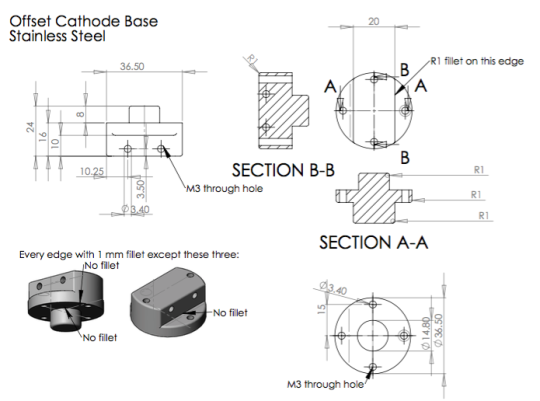Experiments on MAGPIE are expensive in terms of time and equipment – at best we can achieve one experiment a day – we really want to be sure a design will work before we put that much effort in! We use computer aided design (CAD) software (Solidworks) to make 3D models of new hardware, which we can then position inside a model of the vacuum chamber to check what we’ll be able to see from outside.

CAD drawing of an experimental load on MAGPIE, shown as a cut away section. This load was described in an earlier blog post – after two shots we’ve never returned to it…
Once we’re happy with the models, they can be converted to scale drawings which the Mechanical Workshop at the Physics Department use to manufacture the hardware. The workshop employs skilled machinists who work out the best way to make out whatever our latest crazy idea is, and they’re very patient with us. It can take around a month for a component to be machined due to the high demand on the workshop, and we usually don’t get spares of most parts.

Mechanical drawing of a single part for our ‘Horizontal Array’ experiments.
This hardware is then assembled in the chamber and used in a shot on MAGPIE. When things are subjected to million ampere electrical pulses they tend to behave in unpredictable ways, and things often go quite wrong.

Broken glass (top left) fills the chamber after this load (bottom right) hurls shards of brass rod in every direction. A vacuum window was broken, which caused the vacuum chamber to return to atmospheric pressure rather quickly, with a terrifying screech. This is the Mk I – the Mk II didn’t cause any permanent damage, but still didn’t work properly. The Mk III is under construction at the moment.
At this stage it’s back to the drawing board, which can mean a long time before the next iteration can be tested – there’s a week of redesign, four weeks in the workshop and a few more waiting for time on MAGPIE to available for testing. We try as hard as possible to ensure our experiments work before we actually try them, but one of the exciting parts of plasma physics is how unpredictable it is.
One recent innovation we’ve been making use of is laser cutting:
Video by George Swadling
Here, a jet of pure oxygen flows over a sheet of metal whilst an intense laser is focused down to a small point. The laser heats a thin sheet of metal and it burns rapidly in the oxygen jet, cutting straight through the sheet. The laser head is computer controlled and can move rapidly, so it can cut complicated patterns out very quickly using instructions from a computer file. The turn around time for laser cuts parts is often less than a day, and we can lots of copies made, or versions with slight differences so we can compare which works best.
I’ve designed several loads using laser cut hardware now, and it requires a bit of creative thinking to work out how to use on thin sheets of metal and connecting rods. By far the oddest looking thing I’ve designed is an attempt to rotate an existing experiment by 90′ to improve diagnostic access:

This hasn’t been built yet, but doubtless it too will need several months of redesign, tweaks and polishing before we can start doing science with it. I really enjoy designing and testing the unusual concepts we’re coming up with at MAGPIE, so I’ll be having fun regardless of whether it works or not!